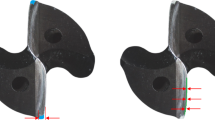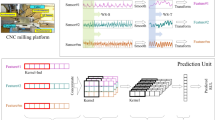Abstract
High Speed Machining (HSM) is a critical process notably found in precision machining, where selecting optimal tools can significantly improve performance. Traditional methods for selecting the optimal tool rely heavily on operator experience, leaving room for automatic solutions. To address this challenge, we propose an innovative recommendation system that leverages machine learning techniques through Deep Factorization Machines (DeepFM). The proposed method utilizes a dataset comprised entirely of theoretically derived annotations provided exclusively by experts in the field of tool manufacturing. Furthermore, we incorporate the geometric characteristics of each tool extracted from a database following the ISO 13399 technical standard. We demonstrate that this implementation is reliable and propose a detailed user feedback framework that will be used to tune the dataset through lifelong learning.
Access this chapter
Tax calculation will be finalised at checkout
Purchases are for personal use only
Similar content being viewed by others
References
Iso 13399: Cutting tool data representation and exchange (2006), international technical standard for the computer-interpretable representation and exchange of industrial product data about cutting tools and toolholders
Aggogeri, F., Pellegrini, N., Tagliani, F.L.: Recent advances on machine learning applications in machining processes. Appl. Sci. 11(18), 8764 (2021). https://doi.org/10.3390/app11188764
Awale, A., Inamdar, K.: Review on High Speed Machining of Hard Material. Journal of emerging technologies and innovative research (2015)
Cheng, H.T., et al.: Wide & Deep Learning for Recommender Systems (2016). https://doi.org/10.48550/arXiv.1606.07792
Chicco, D., Warrens, M.J., Jurman, G.: The coefficient of determination R-squared is more informative than SMAPE, MAE, MAPE, MSE and RMSE in regression analysis evaluation. PeerJ Comput. Sci. 7, e623 (2021). https://doi.org/10.7717/peerj-cs.623
de Aguiar, M.M., Diniz, A.E., Pederiva, R.: Correlating surface roughness, tool wear and tool vibration in the milling process of hardened steel using long slender tools. Int. J. Mach. Tools Manuf. 68, 1–10 (2013). https://doi.org/10.1016/j.ijmachtools.2013.01.002
Dewes, R.C., Aspinwall, D.K.: A review of ultra high speed milling of hardened steels. J. Mater. Process. Technol. 69(1), 1–17 (1997). https://doi.org/10.1016/S0924-0136(96)00042-8
Du, M.H., Wang, S.S., Li, A.Z.: Numerical simulations of the influence of the tool geometric parameters on cutting forces and temperatures in high-speed machining of Ti6Al4V. Appl. Mech. Mater. 217–219, 1802–1810 (2012). https://doi.org/10.4028/www.scientific.net/AMM.217-219.1802
Duan, C., Dou, T., Wang, M.: Notice of Retraction: Research on influence of material hardness and cutting conditions on serrated chip formation during high speed machining of AISI 1045 hardened steel. In: 2010 2nd International Conference on Computer Engineering and Technology, vol. 5, pp. V5–552–V5–555 (2010). https://doi.org/10.1109/ICCET.2010.5486196
Guo, H., Tang, R., Ye, Y., Li, Z., He, X.: DeepFM: A Factorization-Machine based Neural Network for CTR Prediction (2017)
He, X., Chua, T.S.: Neural Factorization Machines for Sparse Predictive Analytics (2017). https://doi.org/10.48550/arXiv.1708.05027
Jun, Z.: Tool Materials for High Speed Machining and Their Fabrication Technologies. Materials for Mechanical Engineering (2006)
Koren, Y., Bell, R., Volinsky, C.: Matrix factorization techniques for recommender systems. Computer 42(8), 30–37 (2009). https://doi.org/10.1109/MC.2009.263
Lundberg, S.M., Erion, G., Chen, H., DeGrave, A., Prutkin, J.M., Nair, B., Katz, R., Himmelfarb, J., Bansal, N., Lee, S.I.: From local explanations to global understanding with explainable AI for trees. Nature Mach. Intell. 2(1), 56–67 (2020). https://doi.org/10.1038/s42256-019-0138-9
Muhammed, B., Srimannarayana, P., Das, P., Gautham, B.P.: An intelligent recommender system for tool selection in conventional machining. International Journal of Computer Integrated Manufacturing (2023)
Parisi, G.I., Kemker, R., Part, J.L., Kanan, C., Wermter, S.: Continual lifelong learning with neural networks: a review. Neural Netw. 113, 54–71 (2019). https://doi.org/10.1016/j.neunet.2019.01.012
Qu, Y., et al.: Product-based Neural Networks for User Response Prediction (2016). https://doi.org/10.48550/arXiv.1611.00144
Rendle, S.: Factorization machines. In: 2010 IEEE International Conference on Data Mining, pp. 995–1000 (2010). https://doi.org/10.1109/ICDM.2010.127
Tang, D.W., He, Z.F., Lv, X.J., Peng, C.: Effect residual stress on material hardness by finite element simulation during the process of high speed cutting. Key Eng. Mater. 719, 23–27 (2017). https://doi.org/10.4028/www.scientific.net/KEM.719.23
Zhang, B., Du, Y., Liu, H., Xin, L., Yang, Y., Li, L.: Experimental study on high-speed milling of SiCf/SiC composites with PCD and CVD diamond tools. Materials 14(13), 3470 (2021). https://doi.org/10.3390/ma14133470
Zhangiang, L., Xing, A.: Cutting tool materials for high speed machining. Progress in Natural Science (2005)
Zhou, G., Yang, X., Zhang, C., Li, Z., Xiao, Z.: Deep learning enabled cutting tool selection for special-shaped machining features of complex products. Adv. Eng. Softw. 133, 1–11 (2019). https://doi.org/10.1016/j.advengsoft.2019.04.007
Author information
Authors and Affiliations
Corresponding author
Editor information
Editors and Affiliations
Ethics declarations
Disclosure of Interests
The authors have no competing interests to declare that are relevant to the content of this article.
Rights and permissions
Copyright information
© 2025 The Author(s), under exclusive license to Springer Nature Switzerland AG
About this paper
Cite this paper
Guerne, J. et al. (2025). Geometrically-Informed Tool Recommendation in High-Speed Machining. In: Santos, M.F., Machado, J., Novais, P., Cortez, P., Moreira, P.M. (eds) Progress in Artificial Intelligence. EPIA 2024. Lecture Notes in Computer Science(), vol 14967. Springer, Cham. https://doi.org/10.1007/978-3-031-73497-7_33
Download citation
DOI: https://doi.org/10.1007/978-3-031-73497-7_33
Published:
Publisher Name: Springer, Cham
Print ISBN: 978-3-031-73496-0
Online ISBN: 978-3-031-73497-7
eBook Packages: Computer ScienceComputer Science (R0)




